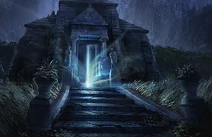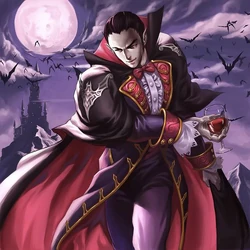Also Called[]
- Nosferatu
- Upeer/Upior (Upiór)/Upir (Upír)/Upyr
- Vampir/Vampyre
- Wampior/Wampir/Wąpierz
Origins[]
The Vampire is one of a race of creatures with origins in mythology, legend and folklore all around the world. No one place can be stated as the true origin of vampiric existence, culture or society. Despite this, they do have close relatives in Greece; namely, the Vrykolakas, Mormo, Empusa, Lamia and others; in Romania and elsewhere in Eastern Europe, there are Strigoi, Moroi and others; in Africa, there are Asanbosam, Obayifo and others; in India, there are Vetala and others. And many other relatives of true vampires exist, all around the world. Some even trace the cultural and ethnic origins of vampires, and attribute to them a connection to ghosts, witches and werewolves.
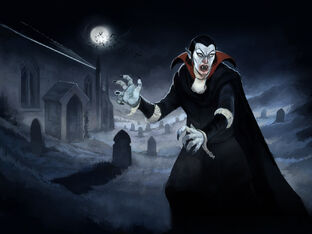
Count Krupke heads to gather up his coffin and leave this graveyard...
There is also a range of variation in how subjects can be converted into vampires.
Most commonly, subjects are turned by the bite of another vampire (ie transfer of a curse or a virus). However, a curse can also be laid on a subject by those who practice witchcraft or devil worship. Someone can also change into a vampire by ingesting the blood of another vampire. A vampire can also result from being given an improper burial (ie being buried unbaptized), or in some cases, if the deceased rejected their church. Some can even be changed to vampires just from having an animal (often a cat or dog) walk across or or jump over their grave.
Appearance[]
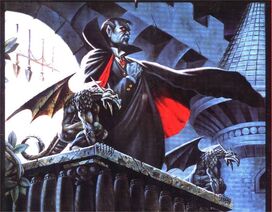
Count Tremaine Vayne-Draynor overlooks Kairopterah Manor...
The appearance of the vampire varies slightly more than most humanoid species. Some who study vampire culture and society have even taken to dividing the appearance of vampires into several categories. For example:
- Chiropteran vampires- humanoid in appearance, but also combining the characteristics of a bat; perhaps they will have a bat snout in the place of a normal nose, or the presence of great bat wings; even perhaps beady eyes, bat fur covering their body, batlike habits or the inability to communicate beyond a series of animal squeaks, shrieks and clicks.
- Gravetouched vampires- bloated relative to their living appearance; flushed, bruise-colored or otherwise darkened as if in the process of decay; hair and nails may have grown, but fangs may take time to develop.
- Demonic vampires- humanoid in appearance, but with infernal traits, such as fangs elongated more than normal (or all teeth being razor sharp fangs, not just the canines), eyes slit like cats or reptiles, eyes that are particularly bright (perhaps stark-white or pitch-black); in some cases, a prognathic face and/or markedly pronounced, furrowed brow.
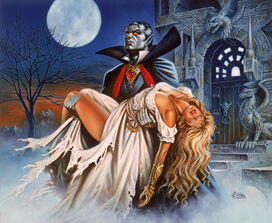
The Count prepares to take his new bride...
- Draculian vampires- humanoid in appearance, dressed in aristocratic clothing (or clothes appropriate to the times); only barely distinguishable from humans or similar humanoids.
- Nosferatu vampires- gaunt, with wide eyes, pointed ears and particularly long claws; the two central incisors are more elongated, rather than the canine teeth.
Otherwise, the skin of vampires can be nearly any of the typical human skin colors. Their eyes can be nearly any color. They can have nearly any hair color, length or texture. Not to mention, the smell of death --or rather, undeath-- that clings to the undead, also varies (growing more apparent with the length of time one has been a member of the undead).
Though, for the most part, a few things remain fairly constant about vampires' appearance and presence. Their skin color tends to be paler than others of their ethnicity (especially those of European and East Asian descent); though, this may vary depending on how recently a vampire has ingested blood, with a recent fill causing a flushed appearance, like full-body blushing. And it is almost certain that when one has the misfortune to encounter a vampire, that vampire will have fangs (rather than needing blades or the like to draw blood).
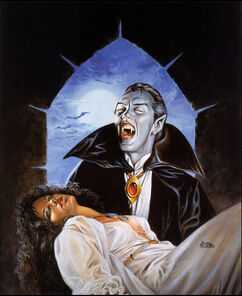
"Do not resist...this will be over before you know it..."
Behavior[]
Vampires are highly social creatures. Their feeding habits demand it. They are often highly sexual and many are fond of a decadent, partying, hedonistic lifestyle. However, their gregarious nature does not simply extend to potential prey. They are also known to live in large groups called covens or nests (though the term "coven" is more common if the nest is comprised mainly/only of female vampires, or if a female vampire leads the group).
This hierarchical living arrangement often determines their behavior toward others in the group, as well as others outside of the group. The leader is often most powerful. They eat first, and eat the most. They may even eat it all if they desire, and the deference of subordinates often means they would go hungry without a word. The leaders are often most gregarious; they are fondest of throwing parties, and come across as much more charming than their subordinate counterparts (or 'unaffiliated' vampires, who belong to no nest of their own at all).
Beneath a leader is often a right-hand; a sidekick or assistant who is most dependable to keep the others in check. This one is second-most social, and will often step aside if the leader decides to take the prey instead. They are the most fiercely loyal, the most patient with any changes in mood, and most diligent in serving the leader. They also have the most lenience when interacting with the leader. It is not uncommon that the leader may take them as a lover (regardless of sex). More than one right-hand may exist within a given nest.
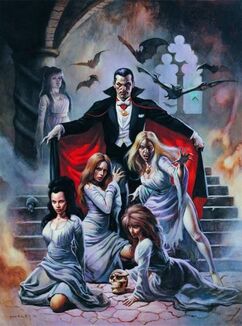
The Count and his harem...
After the right-hand comes the elders. The authority held by an elder varies. In some cases, elders can double as the leaders of the nest. Though, in some cases, elders serve in the place of the right-hand, offering advice and counsel (or they may find themselves competing with a chosen right-hand for the respect and attention of the leader). If the elder is weakened in some capacity, some may find themselves on par with a mere subordinate.
And beneath the elders, the subordinates themselves. They may be members of the leader's harem, servants, trackers or hunters, scouts, members taken in from another nest or the like. Either way, their sole job is doing what they are told. They take the most abuse, rest (and probably eat) the least, and still get about the least respect of all other members of the nest.
But the lowest of all in the nest is a sycophant (also called a familiar or a "blood doll"). In truth, these are not even vampires at all; rather, they are humans (or other humanoids) taken in by the nest. They are either enslaved, indebted or (most commonly) desire to be numbered among the legions of the undead. As such, they offer their total allegiance as servants, scouts (for vampires unable to go out in sunlight) and the like. They may even occasionally be fed upon by their masters; though, until such time they are deemed worthy of being turned into vampires with a bite, blood is drawn with a blade, or the like, rather than directly drained.
Abilities[]
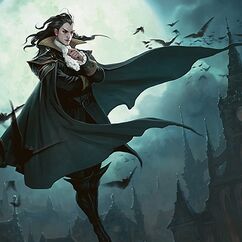
It's so much easier to scope out prey from above...
The abilities of the vampire race are highly varied. They range in both the physical and the mental. The following are among the most common:
- Animal Communication- the ability to psychically perceive, communicate with and/or command animals
- Canine Communication- some vampires can communicate with canines (specifically dogs and/or wolves).
- Chiropteran Communication- some vampires can communicate with bats.
- Rodent Communication- some vampires can communicate with rodents (specifically rats).
- Catoptric Imperceptibility- the ability to go unseen in mirrors and other reflective surfaces; some vampires cannot even be seen through glass windows or the like.
- Conversion- the ability to change others into vampires; this is always achieved by a bite that breaks the skin and draws blood.
- Hypnotism- the ability to render subjects into a suggestible state of consciousness.
- Hypnotic Charm- the ability to channel hypnotic power through gestures and social interactions.
- Immortality- the ability to potentially live forever, if one avoids contact with weaknesses specifically lethal to vampires.
- Manifestation- the ability to supernaturally announce oneself; sometimes, the arrival of a vampire is heralded by a mist, and their presence may disturb animals.
- Natural Weapons- the ability to make use of harmful body features.
- Natural Claws- the ability to make use of sharp, piercing nails.
- Natural Fangs- the ability to make use of sharp, piercing teeth.
- Peak Condition- the ability to make use of an anatomy with optimum function and/or aesthetic appeal.
- Psychic Persuasion- some vampires can simply compel others to do their bidding, rather than having to win them over.
- Rapid Regeneration- the ability to heal from illness and injury to an extent beyond human norms.
- Shapeshifting- the ability to alter physical appearance to assume a new form.
- Chiropteran Form- some vampires can assume the form of a bat or a swarm of bats.
- Lupine Form- some vampires can assume the form of a wolf.
- Mist Form- some vampires can assume the form of a mist (in some cases, a red mist).
- Superhuman Accuracy- the ability to aim with precision beyond human norms.
- Superhuman Agility- the ability to maneuver with grace beyond human norms.
- Superhuman Awareness- the ability to maintain alertness and vigilance beyond human norms.
- Superhuman Dexterity- the ability to maintain physical balance and coordination beyond human norms.
- Superhuman Durability- the ability to resist physical injury beyond human norms.
- Superhuman Metabolism- the ability to access internal bodily processes with efficiency beyond human norms.
- Superhuman Reflexes- the ability to coordinate reactions with speed beyond human norms.
- Superhuman Senses- the ability to intake and process sensory stimuli beyond human norms.
- Superhuman Speed- the ability to move with quickness beyond human norms.
- Superhuman Strength- the ability to exert physical force beyond human norms.
- Hyperbite- vampires often have jaw strength that, when combined with their Fangs, is sufficient to break skin, as well as grip the neck of their chosen prey.
- Telepathy- some vampires can perceive thoughts from and/or broadcast thoughts to the minds of others.
- Undead Form- being members of the undead, vampires do not have a heartbeat/pulse, and do not need to breathe.
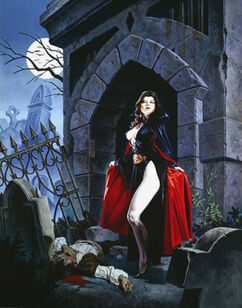
But it's so much more fun to just draw the prey to you...
Weaknesses[]
- Entry Restriction-
- Holy Symbols-
- Reproduction Restriction- Generally, Vampires are unable to reproduce sexually, relying on their power to convert people by a bite in order to produce more of their kind. Living Moroi have been known to bypass this restriction (as well as Vampires biting pregnant victims, affecting the unborn baby), thus producing Dhampirs.
- Running Water-
- Sanguine Sustenance-
- Sunlight-
- Wooden Stakes-
